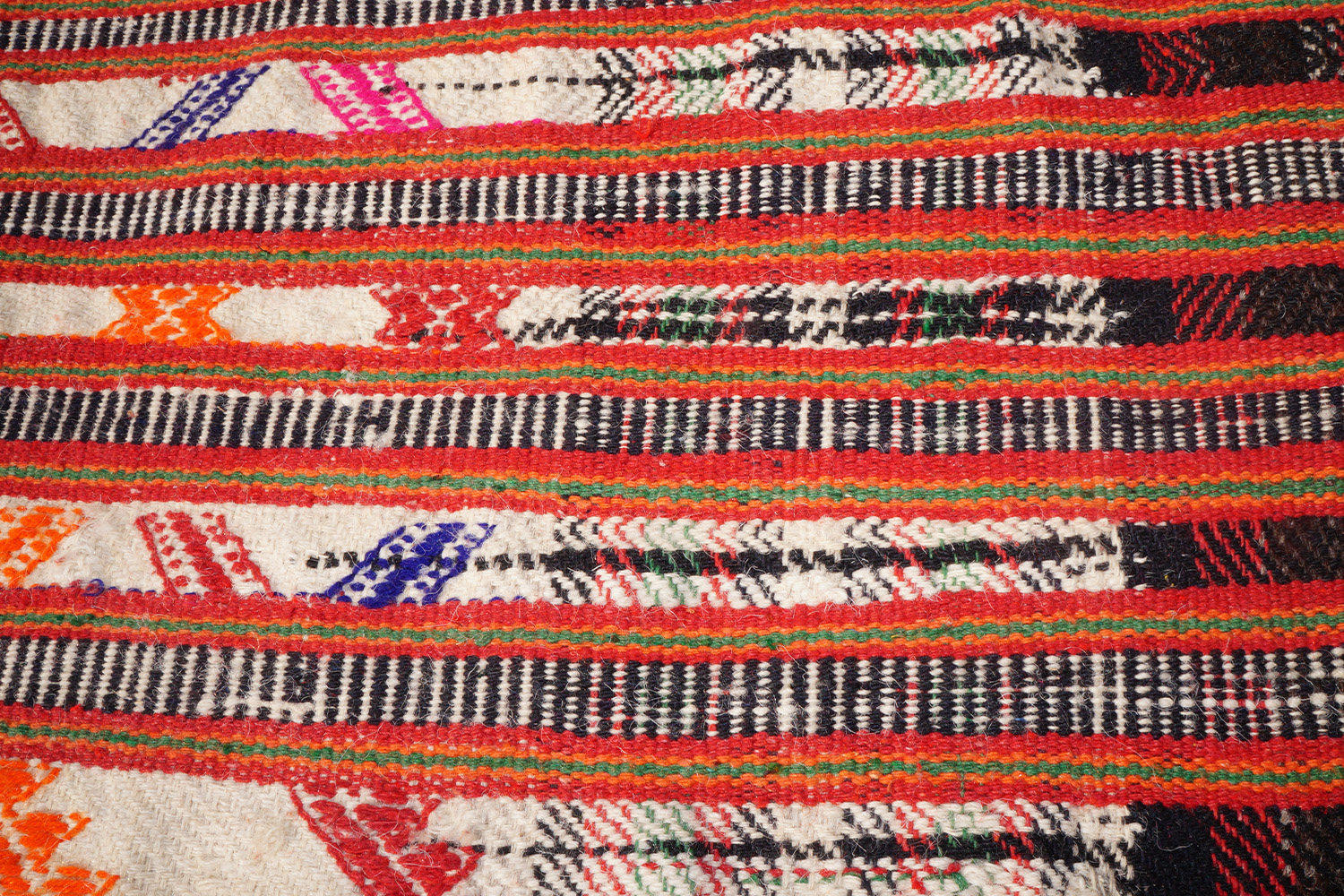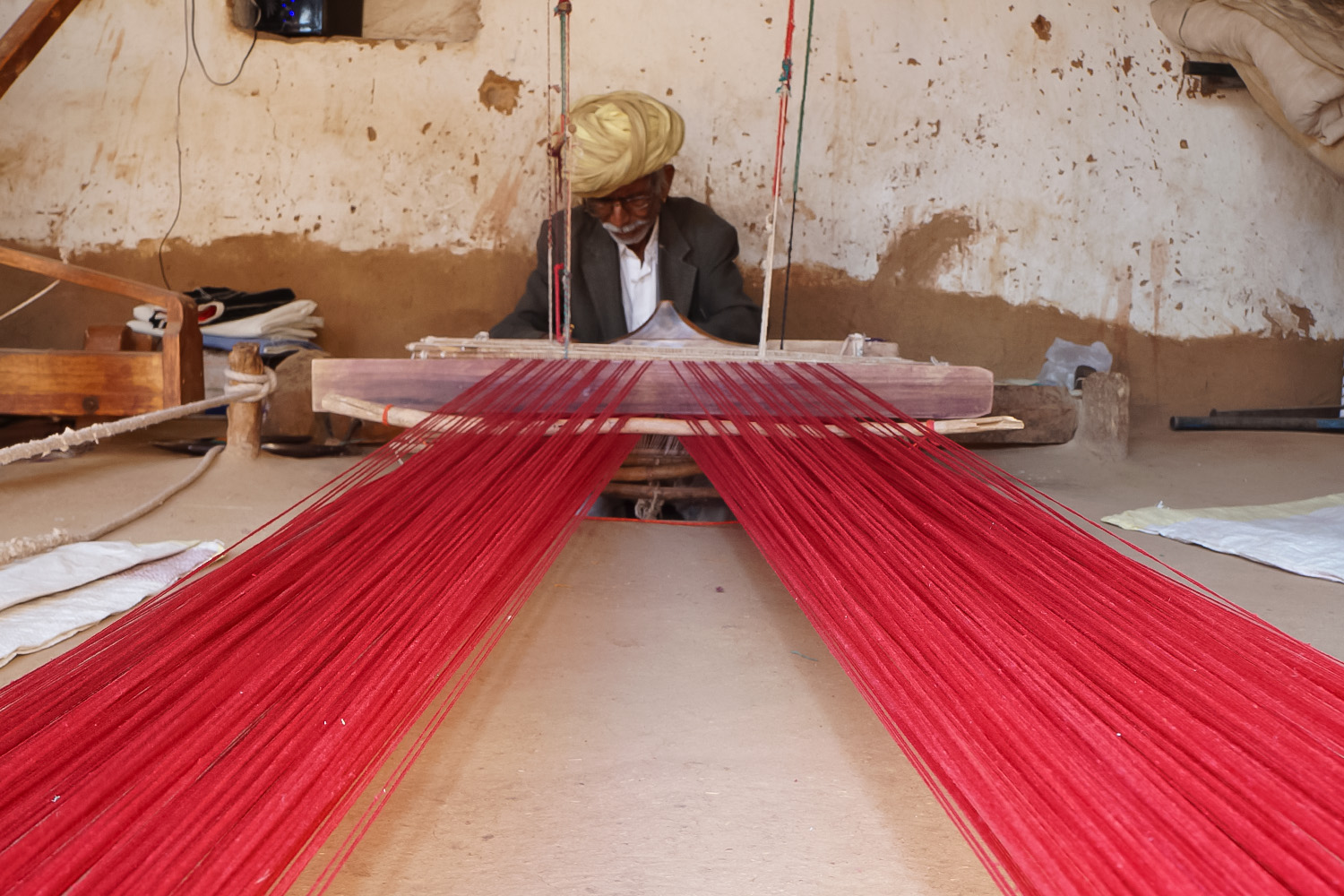ARTICLE
Rajasthani Pattu Weaving
Used for weaving wool in narrow strips, or patti, that are then stitched together, pattu is a technique employed in Rajasthan, typically for making shawls. Primarily made by the farming and cattle-rearing Meghwal community, pattu shawls are worn by men and women of all the communities in the region. These shawls are culturally important within the Meghwal community, especially in marriage rituals, wherein brides’ families gift them to the grooms and elder male family members in a gesture called odhavani — literally, ‘to drape someone’. An exchange or gifting of pattu shawls between men also signifies high respect and a brotherly bond. A variety of patterns is seen in the fabric, and young men, women and older men traditionally don different styles of pattu shawls. Pattu weaving is distinctive in its use of extra wefts that create the appearance of fine embroidery, to create geometric motifs and patterns.
The process of pattu weaving traditionally begins with the shearing of wool from sheep or camels using a razor, or ustra. The raw wool is given to the women of the community to spin into yarn on a charkha. While originally the shawls were woven using the natural colours of the wool — warm white, beige, brown and black — today synthetically dyed yarn is commonly used. Vat, sulphur and acid dyes are locally used to obtain yarn in vibrant colours such as bright reds, pinks, blues and greens. The weft yarn is densely wound onto a metal cylinder; the extra weft yarn is wound onto a small stick. The warp threads are stretched between iron lease rods in a large open space, where they are often treated with a sizing paste — a dilute mixture of wheat flour in water — to increase the strength of the yarn. In this process, the paste is poured over the bundled yarn and continuously pressed into the threads by hand to ensure that it penetrates the fibres. Once the yarns are damp but no longer wet, they are separated by running a comb through them, which also serves to even out the sizing paste and remove excess starch.
After the yarn has been prepared, it is moved over to a pit loom, locally known as khaddi. Here, narrow panels of fabric are first woven individually, to be later sewn together using an interlocking stitch, known as khilan. The base fabric of the pattu is created in either a plain or twill weave. Motifs are added on using the extra-weft technique, wherein weft thread of a colour contrasting that of the base cloth is inserted into the weave after every two picks, often creating an effect of intricate embroidery. The motifs are derived from nature and the immediate environment. Commonly seen motifs include chatri (triangle) representing a temple, kangsiya or damru (pellet drum), machli (fish), burdi (hut), tataiya (wasp) and chidia (bird), which are interpreted geometrically using lines, triangles, rectangles and diamond shapes.
Pattu fabrics are classified into several different types, based on their region of origin and pattern of motifs and colours used. The simple pattu comprises a plain base in a neutral colour, with no motifs and adorned with only a border, and is commonly used for shawls for older men in the region. Traditionally, brightly coloured shawls are used by young men, and chequered patterns by the women. Some of the most widely used pattu patterns are hiravalli, which comprises a colourful triple line pattern, and chatri-kangsia, which features temple and pellet drum motifs and is also known as Kashida pattu because of the intricate Kashmiri embroidery it resembles. Others include bhojasari from Jaisalmer, featuring triangular motifs with horizontal stripes in the border; malani from Barmer, which is densely ornamented all over its surface and typically features a fish motif; and bardi and bakla, which have a chequered pattern. Lunkar pattu features a predominantly red body and is used exclusively to make smaller shawls for women.
Pattu weaving has seen changes over the last few decades, most significantly in the raw materials used: the locally collected raw wool has largely been replaced by machine-spun yarn brought in from cities in Rajasthan and northern India, and cotton yarn is also commonly used for its easy availability and versatility. Despite its cultural significance among the region’s communities, the craft has suffered on account of a general decline in the demand for traditional handlooms, coupled with increased competition from cheaper synthetic alternatives. This has led to pattu weavers and dyers to take up other occupations. At the time of writing, the Government of India has schemes in place to showcase pattu woven fabrics in exhibitions, trade fairs and other such platforms to generate interest in the larger urban and international markets. Today, apart from shawls, pattu woven fabrics are also used to create other products such as floor mats, bed and cushion covers, dupattas and bags.
Bibliography
Asia InCH. “Pattu Weaving of Rajasthan.” Accessed March 14, 2023. https://asiainch.org/craft/pattu-weaving-of-rajasthan/.
Meena, Sakshi, and Suruchi Rohani. “Pattu.” Gaatha, February 7, 2020. https://gaatha.com/pattu-weaving-rajasthan/.
Ranjan, Aditi, and M. P. Ranjan. Handmade in India: Crafts of India. Ahmedabad: Mapin Publishing Pvt. Ltd., 2005.
Srivastava, Ankita, and Ankur Saxena. Pattu Weaving: A Sustainable Fabric Manufacturing Technique. Journal of Sustainability and Environmental Management 1, no. 2. (2022): 299–305. https://media.neliti.com/media/publications/432896-pattu-weaving-a-sustainable-fabric-manuf-ffd0ee13.pdf.








